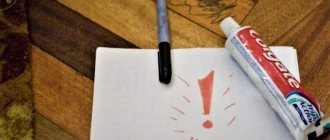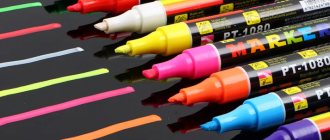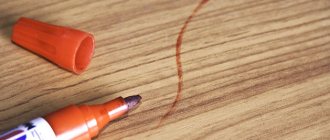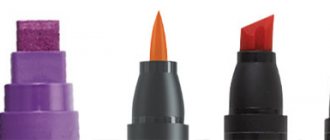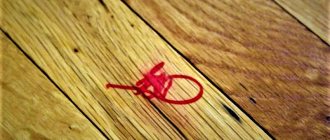What does "permanent" mean?
Let's analyze what this term means. In French and Latin, the word is almost similar and has the same translation: “permanent”, “indelible”. Such a marker is used in various areas where it is necessary to apply an inscription, drawing, sign or sign.
It differs from a simple thick felt-tip pen in that the inscription will not be erased unless you put some effort into it. Currently, it is popular to apply temporary tattoos and draw eyebrows with a permanent marker. After all, with its help you can create any images, not just text. For example, a marker - permanent, white - can easily replace a thin brush with paint for applying various designs to the dark surface of any material. It is thanks to his tenacity and accuracy that he is indispensable in any field. Schoolchildren and students especially like to use it.
Description of markers
Markers differ from each other in three points:
- by the composition of the paint inside the tank;
- different shapes of the body and tip have been developed;
- as intended.
The general constituent elements of the design will allow you to understand what a paint marker is:
- body into which liquid dye is poured;
- the pen is responsible for the uniform application of CM;
- The protective cap prevents the marker from drying out.
Paintwork materials are not applied to loose and rough substrates. The design is used in many industries:
- automotive industry, car repair industry;
- in the wood processing industry;
- in construction;
- in extractive industries;
- in metallurgy;
- in the control and audit structure.
The liquid dye interacts with metal, brick, granite, marble, glass, concrete bases, laminated wood, and plastic.
What surfaces does he write on?
Unlike a felt-tip pen, a permanent marker writes on almost all materials. Suitable for any surface:
- paper;
- disk;
- plastic bag;
- glass:
- stone;
- tile;
- tree;
- textile.
In fact, the list can be endless. But we must remember that such stationery is not omnipotent. If you put an inscription on a plastic, metal canister or bottle with gasoline or oil, it will be erased. There is no need to despair, because even permanent paint gradually comes off.
By the way, it is petroleum products and acetone that will help erase inscriptions and drawings made with a permanent marker. But after treating the surface with petroleum products, you should not immediately make new marks. Remaining oil or gasoline should be completely removed.
Types of paint markers
Classification according to the composition of the dye and the design features of the reservoir for it:
- The pencil is filled with waterproof CM. This is a liquid composition with a high drying speed and a long service life. It is applied with a thin round pen, which allows you to make markings on small areas of the surface and apply small marks that are easy to read. KM refers to wear-resistant compounds that can withstand the UV rays of the sun and the effects of atmospheric factors.
- Filling with CM resistant to aggressive environments. Used as a quick-drying compound in the graphics industry. The design for pouring dye is thought out to the smallest detail: a round metal body, a double-sided felt pen that can be replaced if necessary, a cap with a clip. Marking is carried out on a base made of any material (on metal, glass, plastic, wood, concrete) and is weather resistant. The coloring composition contains no toxic substances. KM can be in an assortment of shades, fluorescent colors are not excluded. Inscriptions are made that are clearly visible on the dark base.
- Stainless steel is marked with paint. It has a high drying speed, low odor, and harmless composition. Often used at nuclear power plants. It contains a small proportion of sulfur and chloride, which allows it to work as a marker on stainless steel. Its design: body made of impact-resistant plastic, double-sided felt nib (can be replaced with a new one).
- Pencil with CM heat-resistant. Contains special pigments and resins. Thanks to them, the marking is readable even at a temperature of +982 o C, black – at a temperature of 1148 o C. The inscription made with colored dye retains the brightness of the color for a long time, is resistant to mechanical wear, and resists the effects of acids, solvents, oils, and aggressive substances. The body for filling the CM is made of metal, the double-sided pen is replaceable.
- KM for temporary marking. Water is used to remove paint. The smooth base leaves no marks. The inscription remains on the surface until it is removed. A special pencil is used during installation work to mark the quality or defects of products. Its design: plastic body, double-sided pen, replaceable.
- Pencil with ultraviolet CM. The liquid composition leaves a mark on the surface and is visible under an ultraviolet lamp. The resulting marking is bright blue. It is applied to a cleaned base and resists weather conditions. The mark is applied in hidden places. The body of the design is made of metal, the pen is double-sided and can be easily replaced.
The marker paint is used repeatedly and does not dry out if the cap is closed after each use. Time is saved at work.
Colors, sizes and shapes of tips
Let's talk about what colors of permanent markers exist. Almost everywhere you can find only these:
- black;
- white;
- red;
- blue;
- green;
- brown.
White and brown, unfortunately, are the least common on sale. Manufacturers strive to produce only popular colors. But a black permanent marker is sold in any office supply department.
An important factor is the thickness, which can range from 0.5 mm to 10 mm. Of course, for small signatures (for example, for disks), a marker 0.5-0.75 mm thick is suitable. In contrast, a warehouse worker would need a marker at least 5mm thick to sign huge boxes.
In addition, there are three types of tips:
- round;
- wedge-shaped;
- beveled
A round one would be most suitable for a warehouse worker, and a beveled one for a school student to sign disks.
Let's figure out what a permanent marker looks like and what it's for, consider the varieties and sizes.
What does "permanent" mean?
First, you need to understand what a permanent marker means. From Latin and French it means "indelible". It is indispensable in many industries where it is necessary to apply text or drawings to various materials.
You need to understand how a permanent marker differs from a regular marker. The key difference is that the applied text does not erase without effort. Now they can draw tattoos and draw eyebrows. It allows you to create any drawings, not just text. Thanks to its stability and accuracy, it is indispensable for many, and it is especially in demand among students.
What surfaces can you write on?
It is also important to understand what you can write on with a permanent marker - it works on materials such as paper, glass and stone surfaces, tiles, wood, and knitwear. But if you write it on a plastic or metal canister or gasoline container, it may be erased.
Petroleum products and acetone are suitable for wiping away marker marks. But after removing the inscriptions with petroleum products, you should not immediately write on the surface again. Before doing this, you need to completely remove traces of oil or gasoline.
Colors, sizes and shapes of tips
To understand what kind of permanent marker it is, it’s worth understanding the variety of shades, sizes and designs. Stationery is available in the following colors: black, white, scarlet, blue, green, brown. White and brown are the most rare and unclaimed. And black can be found everywhere.
When considering the description of a permanent marker, it is worth knowing that its thickness varies between 0.5 - 10 mm. For small signatures, up to 0.75 mm is optimal. Warehouse employees need a 5 mm marker to sign boxes.
There are three types of tips: round, wedge-shaped, beveled. For storage areas, a round tip is optimal, while a beveled tip is suitable for students.
How to choose and why
It is important to understand what a permanent marker is used for in order to choose the appropriate type. So, students need it for signing disks, putting marks on rulers and other tasks. It is used in cases where a pen or felt-tip pen cannot cope.
Another category of tasks that a permanent marker is intended for is that it allows you to write on cans, boxes, equipment, and parts. Gardeners can label containers with seedlings. The letters are not erased with water or liquids with fertilizers, since permanent means stability and durability.
Other Applications
Users need to understand what a permanent marker is used for and in what areas its use is indispensable. You can paint shoes, furniture sets, porcelain tiles - for this you will need to choose the appropriate shade and thickness.
When decorating or painting on glass, it has no analogues. Thus, a white felt-tip pen is optimal for drawing on windows and decorating glasses. The advantage of the marker is its water resistance and maximum clarity of lines. It is indispensable in educational institutions, warehouses and production facilities, and workshops. Answering the question, is it possible to write on disks with a permanent marker - yes, you can decorate the disk.
Types of markers and cleaning methods
Traces where the permanent marker is based on water, chalk, or oil are easily removed. They can be wiped off with dish soap, soap or powder. The alcohol product is removed by alcohol-containing liquids, vodka, and acetone.
It is useful to know how to remove writing if the permanent marker contains paints and varnishes. Such stains can be removed exclusively with concentrated solvents. But they cannot always be used, since there is a risk of damaging the surface. Solvents should not be used to clean plastic products or varnished surfaces.
How to remove permanent marker from things
Users need to know not only what a permanent marker is, but also how to remove traces of it from textiles. Stain removers and bleaches are ideal for this purpose. For white textiles, any product is suitable, but for colored textiles, it is recommended to read the label.
To remove stains from knitwear, you need to dilute the recommended amount of product in water and immerse the item in it. After this, the item must be washed thoroughly.
Methods for cleaning clothes:
- citric acid is ideal for cotton;
- for dense materials - alcohol:
- The satin is cleaned with a mixture of vinegar, milk, and lemon juice.
Remove stains from leather surfaces with alcohol.
Pros and cons of funds
Let's consider the features of using the funds:
- baking soda and toothpaste are found in every home, but they have insufficient effect and can damage delicate fabrics;
- substances with alcohol and acetone can remove marker marks;
- acetone is optimal for cleaning glass, metal, brick, wood;
- WD-40 is highly effective, but contains oils, so it leaves stains on furniture and walls.
You should not rub liquids into surfaces excessively; you just need to choose the right product depending on the material.
Where can I buy
In addition to how to use a permanent marker, it is worth checking out where you can purchase supplies. They are offered in stationery stores individually or as a set. Rare white or brown colors will have to be ordered. You can buy stationery in online stores.
Price
The cost varies from 80 to 600 rubles. and depends on the manufacturer, thickness, purpose. A student should not buy an expensive marker. But when you need to apply large, visible inscriptions, it is recommended to purchase the thickest and highest quality product.
How to choose and why?
Above was a simple example with a warehouse worker and a school student. A student may find a marker useful for more than just disc signatures. Let's assume that there is a large plastic ruler whose numbers on the scale have been erased. With a thin marker you can easily restore the inscription. It is better not to use it for wall newspapers, as there is no point in it. Let the permanent marker be used in necessary cases where neither a pen, nor a pencil, nor a felt-tip pen will help.
You can sign jars with blanks, boxes made of any material, tools and wrenches, and various parts with a permanent marker. It will be convenient for gardeners and gardeners to sign glasses with seedlings. And you don’t have to be afraid that the letters will be erased due to exposure to water or a solution with fertilizers. As stated at the very beginning of the article: permanent means durability and reliability.
For example, the Edding permanent marker has a wide range. The mentioned company manufactures various types of them for their respective purposes. Each marker has its own model, which is written on the body. For example, Edding-750, white. They use inscriptions instead of light paint, which is very convenient.
Alcohol ink markers
This marker leaves an even, clear, translucent mark, which makes it possible to write over logos and factory markings. Its distinctive feature is very fast drying and increased water resistance. The mark left by such a marker can be washed off with acetone or solvent. It is not very suitable for drawing due to its wide shaft. Therefore, it is used when something important needs to be highlighted or emphasized in the text.
Other Applications
No wonder, but this happens! You can use a permanent marker to paint shoes, furniture, and tiles. All that remains is to take the desired color and choose the thickness. When creating decorations or painting on glass, it will become indispensable. For example, a permanent white marker is great for drawing snowflakes on glass. Suitable for decorating holiday glasses. Sometimes you can confuse what is written or drawn with: paint, putty or a marker? After all, the benefit of a permanent marker is not only water resistance, but also extreme accuracy. Therefore, it is used in completely different areas: in schools and universities, in warehouses and factories, in creative workshops. For example, you can beautifully paint a compact disc.
Method of use
When working, it is recommended to have paints in a set. Available: a professional felt-tip pen with CM and the same reservoir with varnish. The varnish layer enhances the color depth of the CM, gives the surface shine, and protects it.
The professional model of the felt-tip pen with dye is easy to use. It works like a regular felt-tip pen.
- Before marking is applied, the body is shaken and the protective cap is removed.
- When you press down on the feather, the dye fills it.
- CM is applied to damaged areas during restoration work; They make readable marks.
- When the CM layer has dried, a varnish composition is applied on top. The average drying time for paint coating is 15 minutes at a temperature of 20 o C. It does not burst even at sub-zero temperatures.
- Wait for the varnish layer to dry and the surface is polished.
Where can I buy?
You can find such markers for sale in regular or specialized office supply stores. But, as a rule, the colors most often sold there are black, blue, red and green. They are also available as a set. If you need white or brown, you will most likely have to order it. If the store does not bring goods to order, then the corresponding online stores will help. In the Moscow region, permanent markers of different colors and thicknesses are often sold in commuter trains or Rospechat kiosks.
What does it consist of?
An industrial marker consists of a refill, a filler, a body and a protective cap. Depending on the task assigned to a certain type of tool, each element can be made of different materials.
The rod, which acts as a writing unit, is made of a porous material that can absorb and conduct moisture, which in this case is ink.
The rod can be made:
- oval shaped;
- round - bullet-shaped;
- in a wedge-shaped, beveled version;
- in a special horseshoe shape for painting wires.
The length of the writing unit is usually 4 mm. Sometimes a metal ball is used as a core, as in a regular ballpoint pen.
The filler for an industrial marker can be:
- water ink;
- benzene ink;
- liquid or solid paint.
Fillers are divided according to their durability into permanent and non-permanent. If the inscription needs to be preserved for a long time, then it is worth using a permanent marker. If necessary, traces of its use can be washed off with alcohol or a plastic eraser.
Chemicals for cleaning plastic
If dirty stains appear on the plastic, first try to remove them using gentle methods. Use toxic solvents and chlorine as a last resort if other methods have not helped.
In the hardware departments of supermarkets you can purchase professional products to wipe off the marker:
- The American aerosol preparation WD-40 . The exact composition of the substance is classified. It is known to contain white spirit and mineral oil. It was developed to kill metal corrosion and as a water repellent. Subsequently, it was discovered that it is useful to use for various household needs. To clean plastic, apply the substance to the stain and rub with a dry cloth.
- Tablefit is in demand for cleaning plastic items . The concentrated liquid has a pleasant odor. Spray it onto the surface and wipe immediately with a cloth. The product is not suitable for products made of ASB plastic.
- Udalix universal stain removal pencil . The Russian brand is produced in Moscow and is available in hardware stores. It removes traces of rust, petroleum products, ink, marker from clothing and can be used to clean plastic. Wet the lettering, rub it with a Udalix pencil until foam forms and wait 15 minutes. You need to wash off the foam with water.
- Professional treatment is provided by the Austrian Antigraffiti from Grass. It quickly removes marker marks and graffiti from plastic. The concentrated liquid is available in a spray bottle. Apply it to the stain, wait 30 seconds and wipe off the dissolved paint with a cloth.
- Himitek Dehydrofobinol has powerful effectiveness . It is designed for degreasing hard surfaces and effectively removes traces of water, alcohol and oil markers. The liquid substance belongs to hazard class 3, so use it carefully, avoiding inhalation of vapors and contact of drops with skin. Wet the napkin, wipe the inscriptions and after 30 seconds, clean them with a rag.
A melamine sponge works well on old and stubborn marker marks. It can be used dry, wiping off the drawn lines. If stains remain, dampen the sponge with water, wring it out and treat the surface again.
Main tasks and properties of the marker
Marking with industrial writing instruments is adapted to the aggressive environment of production shops. Inscriptions with such markers can withstand exposure to solvents and acids, intense mechanical abrasion, and are heat stable.
When marking industrial products with a marker, it is necessary to achieve the effect of maximum visibility, durability and at the same time the ability to correct or delete what has been written. The task assigned to the writing instrument will be performed perfectly, provided that its type meets all conditions.
Lettering written with a quality industrial graphics marker dries quickly and does not crack on vertical surfaces.
A good tool can go from writing on hot metal to marking plastic and wet wood without loss of quality.
Marker in the traditional sense
Since its invention, the marker has undergone significant changes both in composition and in its characteristics. Markers are divided into non-permanent and permanent, that is, erasable and not.
The first to appear were non-permanent markers, known as felt-tip pens. A writing and drawing implement consists of a plastic body, a vented or non-vented cap, a fibrous porous rod impregnated with dye, which ends in an oval or wedge-shaped tip. High-quality markers are environmentally friendly, they are based on water, and they retain their properties for a long time. Some types of markers are disposable, and some can be refilled after you use the paint.
The marker was invented in the middle of the last century in Japan. The first models were banned from production shortly after release due to the high lead content in the composition.
There are different types of simple markers: - children's felt-tip pens for drawing on paper; - children's erasable markers; - light markers for highlighting text (often with a wedge-shaped tip in blue, pink, yellow and green); — markers for marking and writing on CDs and DVDs, films, glass (most often they have a thin rod and blue or black ink with a quick-drying base); — markers for rear projection, used on overhead projectors, transparent foil, plastic and glass; — markers for flipcharts and whiteboards that can be wiped off with a dry sponge or napkin.
What is a water based marker?
Such markers are becoming increasingly popular. This is due to the wide range of colors. It is noteworthy that the range also includes a metallic color, which very successfully imitates real metal.
Some manufacturers of water-based permanent markers add removers to the series. With its help, you can remove the mark left by a varnish marker if it has not yet dried.
A water-based varnish marker will become an indispensable decorator's assistant when it comes to drawing a fine line. In addition, images made with some types of varnish markers can be heat treated to better adhere to the surface. In this case, the pattern cannot be washed off, even using acetone or detergents. In addition, one of the advantages of markers of this type is the ability to refill them with new cartridges and replace refills.
This article is dedicated to useful stationery with which you can draw, write and sketch. This is a "permanent marker". What is it and what is it intended for? Below are the types and sizes of markers, as well as examples of its use.
How to extend service life
Due to the presence of an alcohol component in the felt-tip pen, the paint will quickly evaporate without a protective cap. In order to use a permanent marker for as long as possible, experts recommend following basic rules of use:
- Store the writing utensil in a horizontal position.
- Close the product immediately after use.
If, however, the felt-tip pen stops writing or the ink has dried out, you should extend the working life with the help of an alcohol-containing substance. Add a few drops of cologne, alcohol (diluted) to the rod, removing the protective cap. It is important not to pour in too much alcohol-containing substance, otherwise all the paint will flow out along with the poured liquid.
To restore color intensity, you can use pharmaceutical preparations (Fukartsin, brilliant green, concentrated potassium permanganate), and liquid ink.
The catalog of our online store presents permanent models from world famous manufacturers:
Choose your writing instruments from Stationery Mecca's impressive selection of writing instruments. Please check the terms of payment and delivery with the company manager when placing your order. To keep the felt-tip pen working longer, use it correctly and follow the operating instructions.
Source
For various tasks
The marker filler and its writing unit differ depending on the type of activity and scope of use of the tool.
For inscriptions on wood, use a tool filled with opaque mastic, which is perfectly absorbed into fibrous wood.
For permanent marking of smooth glass, plastic and metal surfaces, a permanent waterproof marker with ink filler is used. Such inscriptions can be removed with an organic solvent.
If durability is not so much important as color brightness and decorative effect, then you should turn to a chalk industrial marker. This tool is filled with liquid chalk in very bright and pure colors. Chalk marker has several features: drying time is a few minutes, resistance to wet environments, and can be washed with a damp sponge.
Plastic surgeons, dermatologists and radiologists use non-toxic medical markers to mark a patient's skin. Traces of such a tool are harmless and are washed off with water.
Marking difficult materials: oily, rusty, rough and constantly wet surfaces is a challenge for solid paint filler. There is no rod as a separate element in such a marker. Its role is played by paint pressed into the shape of a tip. Markers of this type are called “paste markers”.
Main tasks and properties of the marker
Marking with industrial writing instruments is adapted to the aggressive environment of production shops. Inscriptions with such markers can withstand exposure to solvents and acids, intense mechanical abrasion, and are heat stable.
When marking industrial products with a marker, it is necessary to achieve the effect of maximum visibility, durability and at the same time the ability to correct or delete what has been written. The task assigned to the writing instrument will be performed perfectly, provided that its type meets all conditions.
Lettering written with a quality industrial graphics marker dries quickly and does not crack on vertical surfaces.
A good tool can go from writing on hot metal to marking plastic and wet wood without loss of quality.
What does it consist of?
An industrial marker consists of a refill, a filler, a body and a protective cap. Depending on the task assigned to a certain type of tool, each element can be made of different materials.
The rod, which acts as a writing unit, is made of a porous material that can absorb and conduct moisture, which in this case is ink.
The rod can be made:
- oval shaped;
- round - bullet-shaped;
- in a wedge-shaped, beveled version;
- in a special horseshoe shape for painting wires.
The length of the writing unit is usually 4 mm. Sometimes a metal ball is used as a core, as in a regular ballpoint pen.
The filler for an industrial marker can be:
- water ink;
- benzene ink;
- liquid or solid paint.
Fillers are divided according to their durability into permanent and non-permanent. If the inscription needs to be preserved for a long time, then it is worth using a permanent marker. If necessary, traces of its use can be washed off with alcohol or a plastic eraser.
The importance of quality labeling in production
When buying professional tools, expensive machines and high-quality raw materials, you need to make sure that not just anything, but a specialized device will be used for marking. This is an industrial marker. A lot depends on this small tool in production.
Marking defects, distribution of products, marking their sizes - all inscriptions made with a high-quality marker will remain intact under any conditions and will ensure order in the production process.
An industrial marker is a writing instrument for applying information to a variety of surfaces. In this case, the surface can be wood, glass, stone, metal, leather, painted materials and even rust. The requirements for such a marker are very specific.
For various tasks
The marker filler and its writing unit differ depending on the type of activity and scope of use of the tool.
For inscriptions on wood, use a tool filled with opaque mastic, which is perfectly absorbed into fibrous wood.
For permanent marking of smooth glass, plastic and metal surfaces, a permanent waterproof marker with ink filler is used. Such inscriptions can be removed with an organic solvent.
If durability is not so much important as color brightness and decorative effect, then you should turn to a chalk industrial marker. This tool is filled with liquid chalk in very bright and pure colors. Chalk marker has several features: drying time is a few minutes, resistance to wet environments, and can be washed with a damp sponge.
Plastic surgeons, dermatologists and radiologists use non-toxic medical markers to mark a patient's skin. Traces of such a tool are harmless and are washed off with water.
Marking difficult materials: oily, rusty, rough and constantly wet surfaces is a challenge for solid paint filler. There is no rod as a separate element in such a marker. Its role is played by paint pressed into the shape of a tip. Markers of this type are called “paste markers”.
